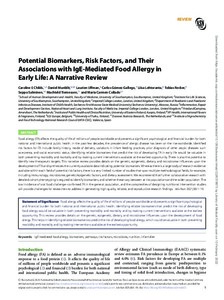Potential Biomarkers, Risk Factors and their Associations with IgE-mediated Food Allergy in Early Life: A Narrative Review
Recker Tobias; Gómez-Gallego Carlos; Munblit Daniel; Lehtoranta Liisa; Salminen Seppo; Childs Caroline E; Collado Maria Carmen; Tiemessen Machteld; Ulfman Laurien
https://urn.fi/URN:NBN:fi-fe2022021519187
Tiivistelmä
Food allergy affects the quality of life of millions of people worldwide and presents a significant psychological and financial burden for both national and international public health. In the past few decades, the prevalence of allergic disease has been on the rise worldwide. Identified risk factors for food allergy include family history, mode of delivery, variations in infant feeding practices, prior diagnosis of other atopic diseases such as eczema, and social economic status. Identifying reliable biomarkers which predict the risk of developing food allergy in early life would be valuable in both preventing morbidity and mortality and by making current interventions available at the earliest opportunity. There is also the potential to identify new therapeutic targets. This narrative review provides details on the genetic, epigenetic, dietary and microbiome influences upon the development of food allergy and synthesizes the currently available data indicating potential biomarkers. While there is a large body of research evidence available within each field of potential risk factors, there are very limited number of studies which span multiple methodological fields, for example including immunology, microbiome, genetic/epigenetic factors and dietary assessment. We recommend that further collaborative research with detailed cohort phenotyping is required to identify biomarkers, and whether these vary between at-risk populations and the wider population. The low incidence of oral food challenge confirmed food allergy in the general population, and the complexities of designing nutritional intervention studies will provide challenges for researchers to address in generating high quality, reliable and reproducible research findings.\nFood allergy affects the quality of life of millions of people worldwide and presents a significant psychological and financial burden for both national and international public health. Identifying reliable biomarkers which predict the risk of developing food allergy would be valuable in both preventing morbidity and mortality and by making current interventions available at the earliest opportunity. This review provides details on the genetic, epigenetic, dietary and microbiome influences upon the development of food allergy. This helps in identifying reliable biomarkers to predict the risk of developing food allergy, which could be valuable in both preventing morbidity and mortality and by making interventions available at the earliest opportunity.
Kokoelmat
- Rinnakkaistallenteet [19207]
